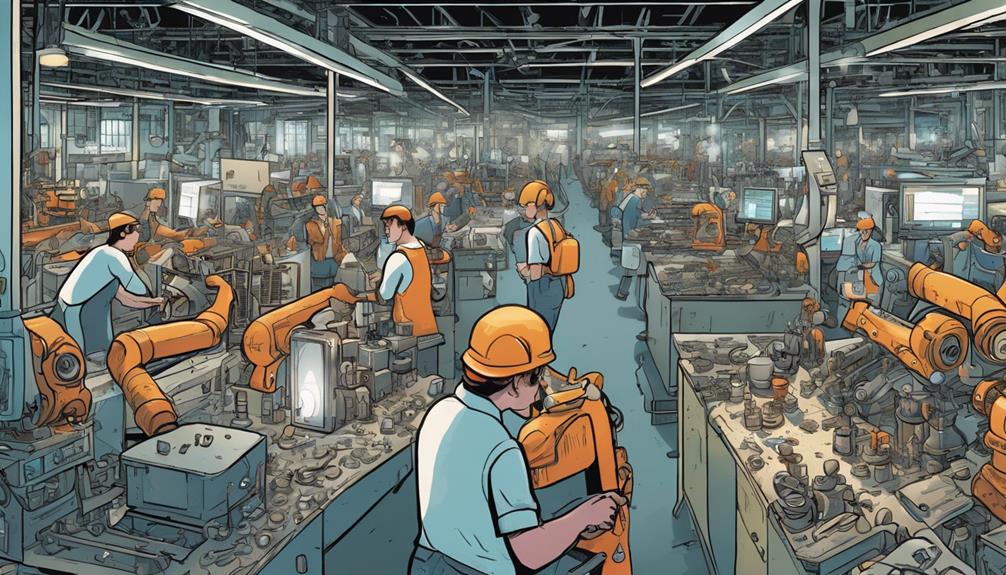If you are looking into promising careers in foundational industries, you will discover a variety of accessible and necessary job openings. These fields, such as agriculture, mining, and manufacturing, typically do not require extensive formal education, which makes getting started easier. You will find a steady job market with positions that value hands-on experience. While many roles can be fulfilling, it is important to consider the physical demands and potential risks associated with these professions. Despite these challenges, the potential for career advancement is significant, especially in specialized areas. There is a wealth of information to uncover about the opportunities and advancements within these sectors that could influence your career trajectory.
Key Takeaways
- Basic industries offer diverse job roles in agriculture, mining, and manufacturing, catering to various skills and interests.
- Many positions require little to no formal education, making career entry accessible for a wide range of individuals.
- Job stability exists due to consistent demand for raw materials, providing a reliable workforce environment.
- Opportunities for advancement and skill development are abundant, especially in specialized roles within the industry.
Understanding Basic Industries
Understanding basic industries is key to grasping how they support the economy by providing essential raw materials for other sectors.
These industries, including agriculture, mining, and manufacturing, form the backbone of economic activity.
You'll find that agriculture involves growing crops and raising animals, while mining focuses on extracting minerals and fossil fuels.
Chemical manufacturing transforms raw materials into useful products, and textile mills convert fibers into various fabrics.
Steel and metal work cater to construction and manufacturing needs.
Career Opportunities Overview

Basic industries not only provide essential raw materials but also offer a wide range of career opportunities across various sectors.
You'll find jobs in agriculture, mining, chemical manufacturing, and textile mills, each presenting unique roles that cater to different skill sets. Many positions require little to no formal education, making it easier for you to enter the workforce.
Practical experience often takes precedence over degrees, especially in hands-on roles. Additionally, the demand for skilled workers creates a stable job market with growth potential.
However, be aware of the physical demands and potential hazards associated with these jobs.
Job Market Analysis

The job market in basic industries is robust, offering diverse opportunities that cater to various skill levels and experiences. You'll find positions in agriculture, mining, and manufacturing that can lead to stable careers.
Here are some key points to take into account:
- High Demand: As foundational sectors, basic industries need a consistent workforce.
- Accessibility: Many roles require minimal formal education, making entry easier for job seekers.
With a variety of job openings available, you can find a position that fits your skills and interests.
Whether you're entering the workforce or looking to switch careers, the basic industries present a promising landscape for employment.
Advantages of Basic Industry Jobs

Working in basic industry jobs offers numerous advantages, making them an attractive option for many job seekers.
For starters, these positions often provide job stability due to the consistent demand for essential materials.
You'll find low barriers to entry, allowing you to start working without requiring advanced education.
Many roles offer on-the-job training, helping you develop valuable skills and adapt to new technologies.
Additionally, there are ample opportunities for advancement within niche areas, ensuring your career can grow.
With a variety of roles available in agriculture, mining, and manufacturing, you can find a job that suits your interests and strengths.
Challenges in Basic Industries

While basic industry jobs offer many advantages, they also come with a range of challenges that can impact workers' experiences and overall job satisfaction. You might face:
- Labor-intensive work that can lead to physical strain.
- Job security that often fluctuates with economic conditions.
These challenges can make it tough to maintain a positive work-life balance. Long hours and repetitive tasks can contribute to fatigue and burnout.
Additionally, while many positions don't require formal education, the demanding nature of the work can still lead to mental stress.
It's crucial to weigh these factors carefully when considering a career in basic industries to guarantee it aligns with your lifestyle and well-being.
Environmental Considerations

Environmental considerations play an essential role in shaping the practices and policies of basic industries, impacting both sustainability and public health.
As you explore career opportunities in these fields, you'll notice that addressing environmental issues is vital. Industries often face scrutiny due to air and water pollution, soil degradation, and greenhouse gas emissions.
By understanding these challenges, you can contribute to innovative solutions that promote eco-friendly practices. Engaging in waste management, recycling, and shifting to renewable energy sources are ways you can make a difference.
Additionally, being aware of land use planning and its ecological implications can set you apart in your career.
Ultimately, your commitment to environmental stewardship can lead to a more sustainable future in basic industries.
Sustainable Practices in Industry

Sustainable practices in basic industries not only enhance ecological health but also create new opportunities for innovation and efficiency. By adopting sustainable methods, you can help reduce environmental impact while promoting economic growth.
Here are a few strategies to contemplate:
- Waste Reduction: Implementing effective waste management systems can greatly lower pollution levels.
- Renewable Energy: Shifting to solar, wind, or other renewable energy sources decreases reliance on fossil fuels.
Notable Companies and Careers

Many notable companies in basic industries are leading the way in innovation and sustainability, offering diverse career opportunities for those looking to make an impact.
Companies like Owens Corning and Boeing are pioneering renewable energy usage, creating roles in engineering, sustainability management, and operations.
If you're interested in the manufacturing sector, Crown Holdings and Cummins focus on eco-friendly processes, providing jobs in production and supply chain management.
Lockheed Martin also offers positions in advanced technology and green practices.
Whether you're starting your career or seeking advancement, these companies value fresh talent and sustainability.
You'll find a range of roles, from hands-on positions to corporate strategy, all contributing to a greener future.
Don't miss your chance to join these industry leaders.
Are Basic Industries a More Stable Career Path Than Consumer Services?
When considering a career in consumer services worth, it’s important to compare the stability of basic industries. While consumer services provide immediate gratification, basic industries offer greater stability during economic downturns. However, consumer services can offer high potential for growth and income, depending on the specific industry and market conditions.
Conclusion
As you stand at the crossroads of your career, think of basic industries as a sturdy bridge leading you to a land of opportunity.
Each step you take can uncover hidden treasures in agriculture, mining, and manufacturing.
While the path may have its bumps, the promise of stability and growth awaits those willing to explore.
Embrace the journey with an open heart, and you might just find that your contributions can help pave the way to a more sustainable future.









